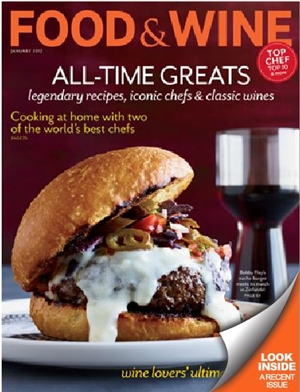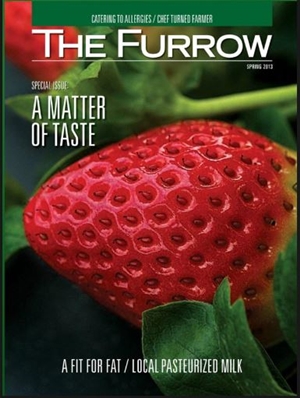Over 100 years ago, a tractor company set out to get the attention of farmers. They didn’t buy advertising or hire salesmen to go door-to-door. Instead, the John Deere Company created a custom print magazine, called The Furrow, designed to educate farmers on developing technology and trends in agriculture. With over 1.5 million copies currently in print and distribution in over 40 countries, this iconic company based in the heartland of America could be considered the first content marketer.
While John Deere Company was an early, early adopter, for many years, print was the sole purview of magazine publishers.
Fast forward to today and while budgets are increasing for digital and content marketing online, (custom content spending on production and distribution rose to 43.9 billion) many brands are using print magazines as a way to engage customers in the offline world. The push to digital has positioned print as “non-traditional” and some have even called print, “the new black”. In some industries like B2B Manufacturing, as many as 60% of companies use print magazines as part of their marketing mix.
Why branded content and print magazines? According to a 2013 Custom Content Council study, customer education, retention and brand loyalty are the primary reasons brands are investing.
As marketers mature in their understanding of a target audience and their preferences for content discovery and consumption, the role of print magazines provide the story formats for topics that are important to customers.
However, a valuable piece of brand content doesn’t exist in a vacuum. In fact, custom content is such an effective medium for brands because it maps back to a broader narrative—the story a brand is telling about itself.
Essentially, content exists to tell a story, which is why, for the right business or brand, developing a print magazine as an offline component of their content marketing strategy offers a unique way to solidify its relationship with its audience while building brand equity.
The world of custom publishing and branded print magazines encompasses every niche, from members only to mainstream retailers to agriculture to luxury hotels. There are currently over 85,000 custom titles in print across a variety of industries.
 With over 2 million consumers of America Express Publishing branded magazines and books, American Express is the forerunner of brand publishing with titles, such as Food&Wine, Travel+Leisure and Departures. What better way to engage with an upscale audience than with print products from the authority on upscale lifestyles?
With over 2 million consumers of America Express Publishing branded magazines and books, American Express is the forerunner of brand publishing with titles, such as Food&Wine, Travel+Leisure and Departures. What better way to engage with an upscale audience than with print products from the authority on upscale lifestyles?
20 million monthly shoppers in Canadian Walmart stores provide ample opportunity for Live Better, which has a print circulation of one million. Four Seasons Magazine claims a readership of 1.1 million in 36 countries, with the average reader boasting a net worth of $4 million. And counterculture favorite, Red Bull’s, The Red Bulletin, boasts 2.5 million monthly printed copies and claims to be one of the largest magazines in the world.
As the traditional magazine industry struggles to retain its footing in the Internet Age, custom publications offer an alternative way for brands to connect with their customers in a meaningful way. The content in branded magazines represents an opportunity for customers to explore a brand that they feel strongly about and one that they already connect with.
It’s about content in context: The branded print magazines that provide real value to readers will thrive even when traditional magazines may be struggling.
Pros of Print Magazines for Brands:
- Opportunity to create something that is uncommon in today’s digital world and stand out in an overcrowded market of branded content
- Create a subscription based connection to consumers about topics that educate, retain and increase brand loyalty
- Print content can be repurposed online to work in concert with online editorial calendars
- Brands don’t have to look too far to find quality content producers in their fields as a result of the sharp turnover in print journalism and the everlasting attraction of appearing in print
- For the cost of a full page ad, an entire branded magazine can be produced
Cons of Print Magazines for Brands:
- The cost of creating and distributing print magazines in comparison to many digital content marketing tactics can seem high
- Gauging ROI can be tricky with no real metrics other than non-paid circulation
- Management buy in may be hard to come by leading to early failure
What Marketers Are Saying About Brand Publishing:
“All media companies are only really competing for the one single non-renewable resource of our audience, which is their time. All of a sudden you have a Red Bull or a General Electric or an IBM, creating such compelling storytelling that you are sharing the time you had from your audience with these brands. That is the larger threat.” Raju Narisetti, vice president of strategy, News Corp
“Folks have been doing this for some time. “I think what is trending is that folks have put a name to a practice with ‘content marketing’, and they’re starting to pay attention to the successes that we and others have had.” David Jones, Publications Manager, The Furrow, the 119-year-old magazine from John Deere
“We feel that in the intimacy of our hotel rooms there is a good opportunity for our guests and a good opportunity for us. People have a lot of time, more time perhaps than they do at home to pick up a magazine. And so it’s an opportunity for guests to explore relevant content, and for us to strengthen our bond with customers.” Alexandra Blum, Director of Global Brand Partnerships for Fairmont Hotels and Resorts
“Why spend €40,000 a page to advertise in Vogue when, for the same amount of money, you can publish an entire magazine?” Alice Litscher, fashion communication professor at the Institut Français de la Mode, Paris
Brand Print Magazine Examples:
Most brands see print magazines as a vehicle to reinforce their brand without directly selling their products. Here are some of my favorites:
LifeTime Fitness – Experience Life

- Award-winning and paid subscription-based healthy-living publication published 10 times a year by Life Time Fitness, a nationwide fitness chain
- Offers a unique no-gimmicks, no-hype content designed to help people achieve your healthy-living goals
Walmart – Live Better

- Each issue is filled with practical and inspiring ideas for Canadians who want to save money and live better.
- 1 million copies of each issue are distributed free in Walmart Supercentres across English Canada.
- Featuring recipes and cooking tips, gorgeous home decor ideas, on-trend clothing and beauty looks to make shopping simpler
- They’ve connected to top names in food, entertaining, health and wellness, beauty, fashion and interior design, rivaling any newsstand print publisher of shelter magazines.
John Deere – The Furrow

- Back issues are fought over on eBay.
- At its peak in 1912, the magazine reached more than 4-million consumers.
- 80 percent still prefer paper to electronic – regardless of their demographic, according to reader surveys.
- The magazine reaches 2 million globally, through the same John Deere network of dealers that distributed the original magazine.
Source: Contently
Red Bull – The Red Bulletin

- 2.5 million monthly print copies in circulation monthly
- Published in Austria, France, Germany, Ireland, Gulf Region, Mexico, New Zealand, South Africa, Switzerland, UK, USA and Brazil
- Languages served: English, German, French, Spanish and Portugues
- Features stories full of action, sports, travel, culture and music, competing with any upscale lifestyle magazine on the market
15 Tips for Content Marketing with a Print Magazine:
These guidelines could easily be called a “style guide” because that is what most print publishers follow. Many brands also have “brand guidelines” that help maintain a consistent voice across multiple communication channels. Ultimately, the best practice is to use guidelines to support the brand’s identity and marketing goals.
- Perform due diligence to understand if a print magazine will resonate with and achieve engagement goals with your customers.
- Be consistent across the brand but not identical across all channels. “Each channel has a unique audience, with distinct preferences for how they absorb information and respond to it,” says Elise Anthony, editorial director at D Custom in Dallas. That means a print magazine should offer complementary, not duplicate, content as found in the brand’s other content marketing tactics.
- With a target audience or group of customer segments in mind, identify the main themes, issues, topics and areas of focus that the magazine content calendar will cover, relevant to your customers. Content marketing answers customers’ questions and brand print magazines are no different.
- Feature relatively timeless, nationally or regionally-oriented content on topics to increase customer affinity.
- Use an existing style guide. Depending on your industry, the Chicago Manual of Style is the go-to source for writers, editors and publishers since 1906 (my preferred style guide) or the AP Stylebook, the journalist’s bible, not to be confused with the APA Style®, which is the manual of the American Psychological Association. Both will serve you well in establishing rules for grammar, citing sources, and so on. Once you choose, don’t mix the two which will only create confusion.
- Establish an internal style guide. Every company has a unique language and/or preference in how they describe their product or service. Industry jargon needs to be spelled out as well as punctuation and capitalization that may be different from the external style guide you’re using. Make the differences clear.
- Define your tone and voice. This can be tricky. Give explicit examples of how to write in your preferred tone. Include sample copy, so that any new writer or editor is clear on what’s expected.
- There are a lot of stakeholders inside and outside the company involved in creating a print magazine. Understandably, marketers are reluctant to widely share brand strategies and propriety research. Distill the guidelines into useful principles while avoiding proprietary information—and then have everyone involved sign non-disclosure agreements.
- Keep your visuals consistent. You want to be sure that the visual content reflects your brand’s voice. This includes fonts, color, layout, and so on.
- Integrate with online channels. Either create an online version of the magazine or cross promote magazine content to current digital publishing channels, such as a blog and social networks.
- Establish a governance process that identifies who is responsible for keeping content up to date and aligned with the brand to guard against brand “drift” as creative teams explore fresh ideas.
- Implement a system that enables all content for the print magazine to be submitted electronically and reviewed by the brand team as they are created.
- Ensure that every print page includes a call to action, such as a unique 800- number or distinct URL to track behavior from your magazine.
- Remember traditional marketing and PR. Tease your social networks and customer community as well as industry bloggers and media about your new magazine. Build buzz and excitement for the launch.
- Track and listen to your readers and subscribers as it echoes via social spaces, communities, sharing, peer-to-peer communication and word of mouth.
With the rise and success of native advertising within existing publications, more brands will look for alternative means to create their own publishing empires with which to attract and engage their customers.
Print magazines are not appropriate for all brands, but for those where storytelling and lifestyle content is essential for customer engagement, print offers a unique opportunity to “own” vs. “rent” their native advertising. Some brand publishers, like Red Bull, are even transforming themselves into a full-fledged media company.
Whatever route you take, whether it’s a special yearly edition or a members-only print publication, print magazines are another way to cater to your customer’s special interests while creating an intimate relationship with the reader.
Has your company ever considered publishing a print magazine? Which print magazines from brands do you read?
If you like in-depth articles like this about content marketing, be sure to visit our index of content marketing tactics.
Photo credit: Shutterstock



